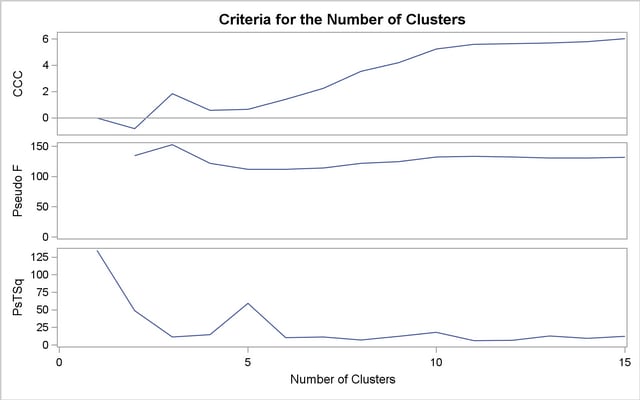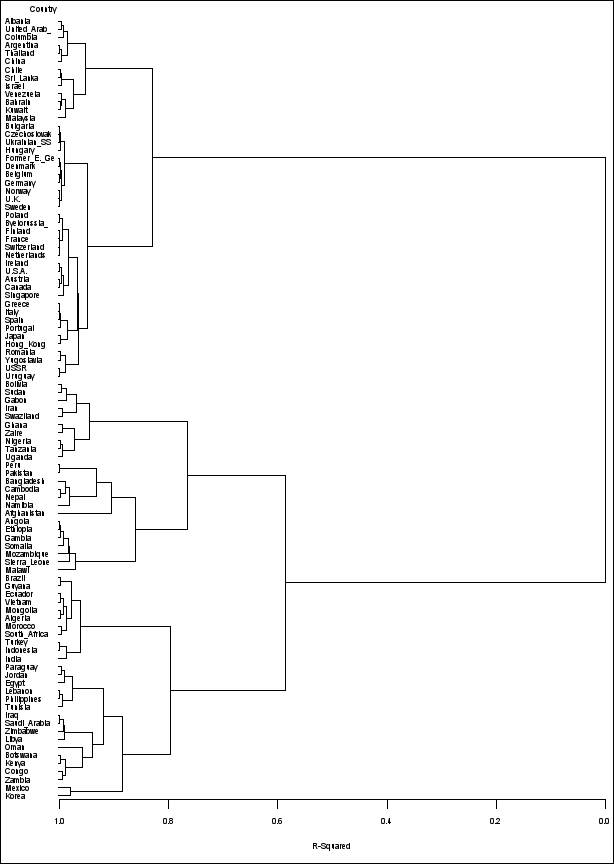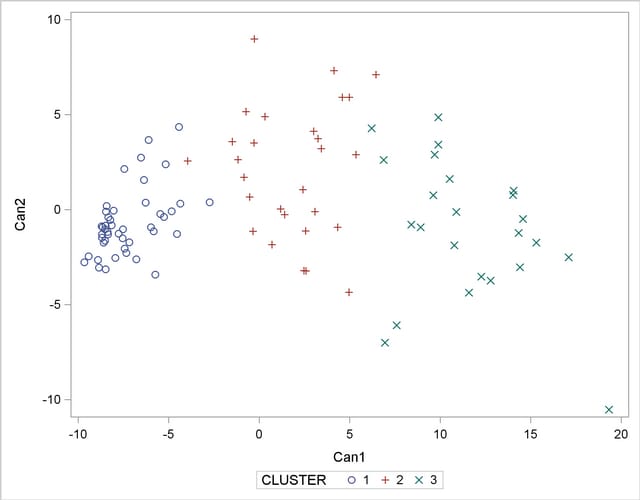| The CLUSTER Procedure |
Getting Started: CLUSTER Procedure
The following example shows how you can use the CLUSTER procedure to compute hierarchical clusters of observations in a SAS data set.
Suppose you want to determine whether national figures for birth rates, death rates, and infant death rates can be used to categorize countries. Previous studies indicate that the clusters computed from this type of data can be elongated and elliptical. Thus, you need to perform a linear transformation on the raw data before the cluster analysis.
The following data1 from Rouncefield (1995) are birth rates, death rates, and infant death rates for 97 countries. The DATA step creates the SAS data set Poverty:
data Poverty;
input Birth Death InfantDeath Country $20. @@;
datalines;
24.7 5.7 30.8 Albania 12.5 11.9 14.4 Bulgaria
13.4 11.7 11.3 Czechoslovakia 12 12.4 7.6 Former_E._Germany
11.6 13.4 14.8 Hungary 14.3 10.2 16 Poland
13.6 10.7 26.9 Romania 14 9 20.2 Yugoslavia
17.7 10 23 USSR 15.2 9.5 13.1 Byelorussia_SSR
13.4 11.6 13 Ukrainian_SSR 20.7 8.4 25.7 Argentina
46.6 18 111 Bolivia 28.6 7.9 63 Brazil
23.4 5.8 17.1 Chile 27.4 6.1 40 Columbia
32.9 7.4 63 Ecuador 28.3 7.3 56 Guyana
34.8 6.6 42 Paraguay 32.9 8.3 109.9 Peru
18 9.6 21.9 Uruguay 27.5 4.4 23.3 Venezuela
29 23.2 43 Mexico 12 10.6 7.9 Belgium
13.2 10.1 5.8 Finland 12.4 11.9 7.5 Denmark
13.6 9.4 7.4 France 11.4 11.2 7.4 Germany
10.1 9.2 11 Greece 15.1 9.1 7.5 Ireland
9.7 9.1 8.8 Italy 13.2 8.6 7.1 Netherlands
14.3 10.7 7.8 Norway 11.9 9.5 13.1 Portugal
10.7 8.2 8.1 Spain 14.5 11.1 5.6 Sweden
12.5 9.5 7.1 Switzerland 13.6 11.5 8.4 U.K.
14.9 7.4 8 Austria 9.9 6.7 4.5 Japan
14.5 7.3 7.2 Canada 16.7 8.1 9.1 U.S.A.
40.4 18.7 181.6 Afghanistan 28.4 3.8 16 Bahrain
42.5 11.5 108.1 Iran 42.6 7.8 69 Iraq
22.3 6.3 9.7 Israel 38.9 6.4 44 Jordan
26.8 2.2 15.6 Kuwait 31.7 8.7 48 Lebanon
45.6 7.8 40 Oman 42.1 7.6 71 Saudi_Arabia
29.2 8.4 76 Turkey 22.8 3.8 26 United_Arab_Emirates
42.2 15.5 119 Bangladesh 41.4 16.6 130 Cambodia
21.2 6.7 32 China 11.7 4.9 6.1 Hong_Kong
30.5 10.2 91 India 28.6 9.4 75 Indonesia
23.5 18.1 25 Korea 31.6 5.6 24 Malaysia
36.1 8.8 68 Mongolia 39.6 14.8 128 Nepal
30.3 8.1 107.7 Pakistan 33.2 7.7 45 Philippines
17.8 5.2 7.5 Singapore 21.3 6.2 19.4 Sri_Lanka
22.3 7.7 28 Thailand 31.8 9.5 64 Vietnam
35.5 8.3 74 Algeria 47.2 20.2 137 Angola
48.5 11.6 67 Botswana 46.1 14.6 73 Congo
38.8 9.5 49.4 Egypt 48.6 20.7 137 Ethiopia
39.4 16.8 103 Gabon 47.4 21.4 143 Gambia
44.4 13.1 90 Ghana 47 11.3 72 Kenya
44 9.4 82 Libya 48.3 25 130 Malawi
35.5 9.8 82 Morocco 45 18.5 141 Mozambique
44 12.1 135 Namibia 48.5 15.6 105 Nigeria
48.2 23.4 154 Sierra_Leone 50.1 20.2 132 Somalia
32.1 9.9 72 South_Africa 44.6 15.8 108 Sudan
46.8 12.5 118 Swaziland 31.1 7.3 52 Tunisia
52.2 15.6 103 Uganda 50.5 14 106 Tanzania
45.6 14.2 83 Zaire 51.1 13.7 80 Zambia
41.7 10.3 66 Zimbabwe
;
The data set Poverty contains the character variable Country and the numeric variables Birth, Death, and InfantDeath, which represent the birth rate per thousand, death rate per thousand, and infant death rate per thousand. The $20. in the INPUT statement specifies that the variable Country is a character variable with a length of 20. The double trailing at sign (@@) in the INPUT statement holds the input line for further iterations of the DATA step, specifying that observations are input from each line until all values are read.
Because the variables in the data set do not have equal variance, you must perform some form of scaling or transformation. One method is to standardize the variables to mean zero and variance one. However, when you suspect that the data contain elliptical clusters, you can use the ACECLUS procedure to transform the data such that the resulting within-cluster covariance matrix is spherical. The procedure obtains approximate estimates of the pooled within-cluster covariance matrix and then computes canonical variables to be used in subsequent analyses.
The following statements perform the ACECLUS transformation by using the SAS data set Poverty. The OUT= option creates an output SAS data set called Ace to contain the canonical variable scores:
proc aceclus data=Poverty out=Ace p=.03 noprint;
var Birth Death InfantDeath;
run;
The P= option specifies that approximately 3% of the pairs are included in the estimation of the within-cluster covariance matrix. The NOPRINT option suppresses the display of the output. The VAR statement specifies that the variables Birth, Death, and InfantDeath are used in computing the canonical variables.
The following statements invoke the CLUSTER procedure, using the SAS data set ACE created in the previous PROC ACECLUS run:
ods graphics on;
proc cluster data=Ace method=ward ccc pseudo print=15 outtree=Tree;
var can1 can2 can3 ;
id country;
format country $12.;
run;
ods graphics off;
The ods graphics on statement asks procedures to produce ODS graphics where possible. Ward’s minimum-variance clustering method is specified by the METHOD= option. The CCC option displays the cubic clustering criterion, and the PSEUDO option displays pseudo  and
and  statistics. The PRINT=15 option displays only the last 15 generations of the cluster history. The OUTTREE= option creates an output SAS data set called Tree that can be used by the TREE procedure to draw a tree diagram.
statistics. The PRINT=15 option displays only the last 15 generations of the cluster history. The OUTTREE= option creates an output SAS data set called Tree that can be used by the TREE procedure to draw a tree diagram.
The VAR statement specifies that the canonical variables computed in the ACECLUS procedure are used in the cluster analysis. The ID statement specifies that the variable Country should be added to the Tree output data set.
The results of this analysis are displayed in the following figures.
PROC CLUSTER first displays the table of eigenvalues of the covariance matrix (Figure 29.1). These eigenvalues are used in the computation of the cubic clustering criterion. The first two columns list each eigenvalue and the difference between the eigenvalue and its successor. The last two columns display the individual and cumulative proportion of variation associated with each eigenvalue.
| Eigenvalues of the Covariance Matrix | ||||
|---|---|---|---|---|
| Eigenvalue | Difference | Proportion | Cumulative | |
| 1 | 64.5500051 | 54.7313223 | 0.8091 | 0.8091 |
| 2 | 9.8186828 | 4.4038309 | 0.1231 | 0.9321 |
| 3 | 5.4148519 | 0.0679 | 1.0000 | |
Figure 29.2 displays the last 15 generations of the cluster history. First listed are the number of clusters and the names of the clusters joined. The observations are identified either by the ID value or by CL , where
, where  is the number of the cluster. Next, PROC CLUSTER displays the number of observations in the new cluster and the semipartial R square. The latter value represents the decrease in the proportion of variance accounted for by joining the two clusters.
is the number of the cluster. Next, PROC CLUSTER displays the number of observations in the new cluster and the semipartial R square. The latter value represents the decrease in the proportion of variance accounted for by joining the two clusters.
| Cluster History | ||||||||||
|---|---|---|---|---|---|---|---|---|---|---|
| NCL | Clusters Joined | FREQ | SPRSQ | RSQ | ERSQ | CCC | PSF | PST2 | T i e |
|
| 15 | Oman | CL37 | 5 | 0.0039 | .957 | .933 | 6.03 | 132 | 12.1 | |
| 14 | CL31 | CL22 | 13 | 0.0040 | .953 | .928 | 5.81 | 131 | 9.7 | |
| 13 | CL41 | CL17 | 32 | 0.0041 | .949 | .922 | 5.70 | 131 | 13.1 | |
| 12 | CL19 | CL21 | 10 | 0.0045 | .945 | .916 | 5.65 | 132 | 6.4 | |
| 11 | CL39 | CL15 | 9 | 0.0052 | .940 | .909 | 5.60 | 134 | 6.3 | |
| 10 | CL76 | CL27 | 6 | 0.0075 | .932 | .900 | 5.25 | 133 | 18.1 | |
| 9 | CL23 | CL11 | 15 | 0.0130 | .919 | .890 | 4.20 | 125 | 12.4 | |
| 8 | CL10 | Afghanistan | 7 | 0.0134 | .906 | .879 | 3.55 | 122 | 7.3 | |
| 7 | CL9 | CL25 | 17 | 0.0217 | .884 | .864 | 2.26 | 114 | 11.6 | |
| 6 | CL8 | CL20 | 14 | 0.0239 | .860 | .846 | 1.42 | 112 | 10.5 | |
| 5 | CL14 | CL13 | 45 | 0.0307 | .829 | .822 | 0.65 | 112 | 59.2 | |
| 4 | CL16 | CL7 | 28 | 0.0323 | .797 | .788 | 0.57 | 122 | 14.8 | |
| 3 | CL12 | CL6 | 24 | 0.0323 | .765 | .732 | 1.84 | 153 | 11.6 | |
| 2 | CL3 | CL4 | 52 | 0.1782 | .587 | .613 | -.82 | 135 | 48.9 | |
| 1 | CL5 | CL2 | 97 | 0.5866 | .000 | .000 | 0.00 | . | 135 | |
Next listed is the squared multiple correlation, R square, which is the proportion of variance accounted for by the clusters. Figure 29.2 shows that, when the data are grouped into three clusters, the proportion of variance accounted for by the clusters (R square) is just under 77%. The approximate expected value of R square is given in the ERSQ column. This expectation is approximated under the null hypothesis that the data have a uniform distribution instead of forming distinct clusters.
The next three columns display the values of the cubic clustering criterion (CCC), pseudo  (PSF), and
(PSF), and  (PST2) statistics. These statistics are useful for estimating the number of clusters in the data.
(PST2) statistics. These statistics are useful for estimating the number of clusters in the data.
The final column in Figure 29.2 lists ties for minimum distance; a blank value indicates the absence of a tie. A tie means that the clusters are indeterminate and that changing the order of the observations may change the clusters. See Example 29.4 for ways to investigate the effects of ties.
Figure 29.3 plots the three statistics for estimating the number of clusters. Peaks in the plot of the cubic clustering criterion with values greater than 2 or 3 indicate good clusters; peaks with values between 0 and 2 indicate possible clusters. Large negative values of the CCC can indicate outliers. In Figure 29.3, there is a local peak of the CCC when the number of clusters is 3. The CCC drops at 4 clusters and then steadily increases, leveling off at 11 clusters.
Another method of judging the number of clusters in a data set is to look at the pseudo  statistic (PSF). Relatively large values indicate good numbers of clusters. In Figure 29.3, the pseudo
statistic (PSF). Relatively large values indicate good numbers of clusters. In Figure 29.3, the pseudo  statistic suggests 3 clusters or 11 clusters.
statistic suggests 3 clusters or 11 clusters.

To interpret the values of the pseudo  statistic, look down the column or look at the plot from right to left until you find the first value markedly larger than the previous value, then move back up the column or to the right in the plot by one step in the cluster history. In Figure 29.3, you can see possibly good clustering levels at 11 clusters, 6 clusters, 3 clusters, and 2 clusters.
statistic, look down the column or look at the plot from right to left until you find the first value markedly larger than the previous value, then move back up the column or to the right in the plot by one step in the cluster history. In Figure 29.3, you can see possibly good clustering levels at 11 clusters, 6 clusters, 3 clusters, and 2 clusters.
Considered together, these statistics suggest that the data can be clustered into 11 clusters or 3 clusters. The following statements examine the results of clustering the data into 3 clusters.
A graphical view of the clustering process can often be helpful in interpreting the clusters. The following statements use the TREE procedure to produce a tree diagram of the clusters:
goptions vsize=9in hsize=6.4in htext=.9pct htitle=3pct;
axis1 order=(0 to 1 by 0.2);
proc tree data=Tree out=New nclusters=3
haxis=axis1 horizontal;
height _rsq_;
copy can1 can2 ;
id country;
run;
The AXIS1 statement defines axis parameters that are used in the TREE procedure. The ORDER= option specifies the data values in the order in which they should appear on the axis.
The preceding statements use the SAS data set Tree as input. The OUT= option creates an output SAS data set named New to contain information about cluster membership. The NCLUSTERS= option specifies the number of clusters desired in the data set New.
The TREE procedure produces high-resolution graphics by default. The HAXIS= option specifies AXIS1 to customize the appearance of the horizontal axis. The HORIZONTAL option orients the tree diagram horizontally. The HEIGHT statement specifies the variable _RSQ_ (R square) as the height variable.
The COPY statement copies the canonical variables can1 and can2 (computed in the ACECLUS procedure) into the output SAS data set New. Thus, the SAS output data set New contains information for three clusters and the first two of the original canonical variables.
Figure 29.4 displays the tree diagram. The figure provides a graphical view of the information in Figure 29.2. As the number of branches grows to the left from the root, the R square approaches 1; the first three clusters (branches of the tree) account for over half of the variation (about 77%, from Figure 29.4). In other words, only three clusters are necessary to explain over three-fourths of the variation.

The following statements invoke the SGPLOT procedure on the SAS data set New:
proc sgplot data=New ;
scatter y=can2 x=can1 / group=cluster ;
run;
The PLOT statement requests a plot of the two canonical variables, using the value of the variable cluster as the identification variable, as shown in Figure 29.5.

The statistics in Figure 29.2 and Figure 29.3, the tree diagram in Figure 29.4, and the plot of the canonical variables in Figure 29.5 assist in the estimation of clusters in the data. There seems to be reasonable separation in the clusters. However, you must use this information, along with experience and knowledge of the field, to help in deciding the correct number of clusters.
Copyright © 2009 by SAS Institute Inc., Cary, NC, USA. All rights reserved.